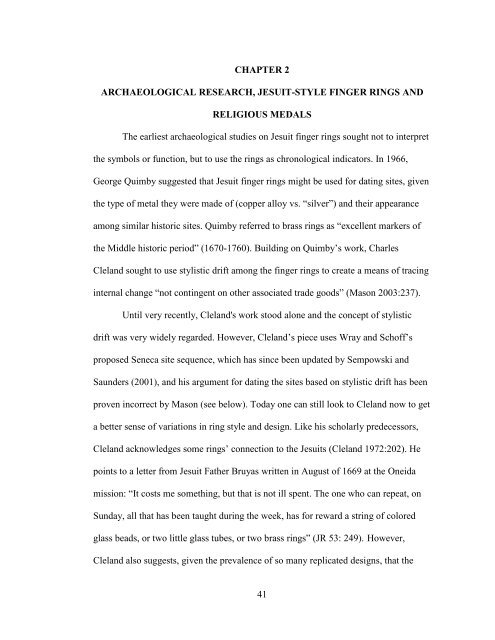archaeological and textual records - eCommons@Cornell - Cornell ...
archaeological and textual records - eCommons@Cornell - Cornell ...
archaeological and textual records - eCommons@Cornell - Cornell ...
You also want an ePaper? Increase the reach of your titles
YUMPU automatically turns print PDFs into web optimized ePapers that Google loves.
CHAPTER 2<br />
ARCHAEOLOGICAL RESEARCH, JESUIT-STYLE FINGER RINGS AND<br />
RELIGIOUS MEDALS<br />
The earliest <strong>archaeological</strong> studies on Jesuit finger rings sought not to interpret<br />
the symbols or function, but to use the rings as chronological indicators. In 1966,<br />
George Quimby suggested that Jesuit finger rings might be used for dating sites, given<br />
the type of metal they were made of (copper alloy vs. “silver”) <strong>and</strong> their appearance<br />
among similar historic sites. Quimby referred to brass rings as “excellent markers of<br />
the Middle historic period” (1670-1760). Building on Quimby’s work, Charles<br />
Clel<strong>and</strong> sought to use stylistic drift among the finger rings to create a means of tracing<br />
internal change “not contingent on other associated trade goods” (Mason 2003:237).<br />
Until very recently, Clel<strong>and</strong>'s work stood alone <strong>and</strong> the concept of stylistic<br />
drift was very widely regarded. However, Clel<strong>and</strong>’s piece uses Wray <strong>and</strong> Schoff’s<br />
proposed Seneca site sequence, which has since been updated by Sempowski <strong>and</strong><br />
Saunders (2001), <strong>and</strong> his argument for dating the sites based on stylistic drift has been<br />
proven incorrect by Mason (see below). Today one can still look to Clel<strong>and</strong> now to get<br />
a better sense of variations in ring style <strong>and</strong> design. Like his scholarly predecessors,<br />
Clel<strong>and</strong> acknowledges some rings’ connection to the Jesuits (Clel<strong>and</strong> 1972:202). He<br />
points to a letter from Jesuit Father Bruyas written in August of 1669 at the Oneida<br />
mission: “It costs me something, but that is not ill spent. The one who can repeat, on<br />
Sunday, all that has been taught during the week, has for reward a string of colored<br />
glass beads, or two little glass tubes, or two brass rings” (JR 53: 249). However,<br />
Clel<strong>and</strong> also suggests, given the prevalence of so many replicated designs, that the<br />
41

















